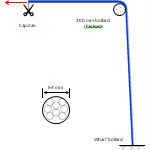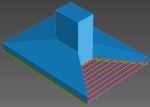| << Previous (Nonlinear) | (Modelling) Next >> |
ST7-R3.40 Applications |
||
|---|---|---|
| ST7-R3.40.20 Applications / Marine | ||
|
0.9 MB |
ST7-R3.40.20.15 Mooring Line Snapback Simulation Mooring line snapback events pose a significant danger in maritime operations, potentially causing severe injury or damage to personnel, equipment and vessels. These events occur when tensioned mooring lines suddenly break or release, resulting in high-speed, unpredictable recoiling movements. Mitigating this risk necessitates thorough testing and planning. Simulating snapback events, using Strand7, complements these efforts; detailed insights into the behaviour of mooring lines during snapback events can be obtained, aiding in the development of effective safety measures and protocols. |

|
| ST7-R3.40.35 Applications / Structural | ||
|
2.9 MB |
ST7-R3.40.35.3 Analysing Membrane Structures Membrane or tension structures are commonly used around the world for a variety of different applications. These typically include shading structures, tents, tarpaulins, marquees, and various other large scale architectural structures such as the Tokyo dome. These structures are highly nonlinear and rely on an internal state of pre-stress to work. |

|
|
5.6 MB |
ST7-R3.40.35.9 Modelling of a Concrete Foundation with Reinforcement This Webnote outlines procedures to model a reinforced concrete foundation. Two methods to construct the model are presented: automeshing and extrusion meshing. In the first method, beam elements are used to model discrete reinforcement; in the second method, plate elements are used to model smeared reinforcement. Additionally, a version of the extrusion mesh is presented whereby incompatible, discrete reinforcement, modelled with beam elements, is attached to the interior of the brick mesh using Attachment links. |

|
|
1.8 MB |
ST7-R3.40.35.50 Insulating Glass Unit with Ideal Gas Cavity Insulating glass units (IGU) consist of two or more panes of glass spaced apart and factory sealed hermetically with dry air or special gases in the unit cavity. To capture the interaction between the panes of glass, the cavity is modelled with an ideal gas cavity attribute in Strand7. This Webnote presents two example IGUs subjected to wind load and temperature increase. |

|
| << Previous (Nonlinear) | (Modelling) Next >> |

 Menu
Menu